Best music video of all time? Quite possibly.
Friday, December 22, 2006
Thursday, December 14, 2006
Zen and the Art of Currency Counterfeiting, Plus a Concise History of the Secret Service
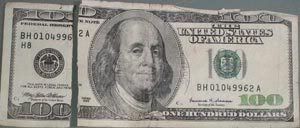
 As if further testifying to the state of detachment I have developed toward just about everything, I was recently amazed at how even a subject so near and dear to peoples' hearts as money (to paraphrase Bob Farina) could fail to evoke anything stronger in me than laughter when I was recently passed counterfeit currency in a moderately large sum.
As if further testifying to the state of detachment I have developed toward just about everything, I was recently amazed at how even a subject so near and dear to peoples' hearts as money (to paraphrase Bob Farina) could fail to evoke anything stronger in me than laughter when I was recently passed counterfeit currency in a moderately large sum.
A few weeks back I sold my G4 tower for $500 on craigslist. Obviously, cash is pretty much the only thing you want to deal with in a transaction like that. So I got a stack of 50s and 100s from the buyer and left them on my desk, gradually using them up for groceries and daily expenses. Saved me several trips to the ATM. I'd made my way down to the last hundred and I scooped it into my wallet last Sunday as I headed off to an internet cafe on Vermont.
The internet cafe experience is a new thing for me, now that I have sold the tower and traded it in for a laptop with wi-fi. Besides "war-walking" (my other habit for picking up free wi-fi access), on cold wet days (such kind as we are frequently getting more of with the arrival of winter) when I have excess time to kill and nothing to do, I will stop in at a cafe for a cup of tea and surf like a true Los Feliz techno-bohemian. ( By the way... support small businesses that offer free wi-fi and piss on Starbucks and other large chains who could easily afford to provide it, but partner up with other mega-giants like Verizon to charge you for it instead. )
Anyway, I was wondering where I should break this hundred. I considered using it at the coffee shop, but the girl behind the counter was young and cute and my chamomile tea was only about $2. I didn't want to risk making her unhappy by emptying out her change drawer, or giving her the idea that I was trying to impress by flashing big money. I decided to break it somewhere else.
Later that night I went to Albertson's up the street and bought about $20 worth of groceries. It seemed like a good time to get some change.
The check-out guy was a man in his 50s. I gave him the bill and he made a two-handed "snap" with his fingers at the edges of the bill: a habit people seem to develop when they handle money all day long. And guess what? The fucking bill split almost clean in half !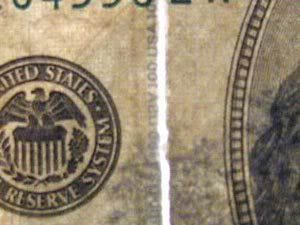
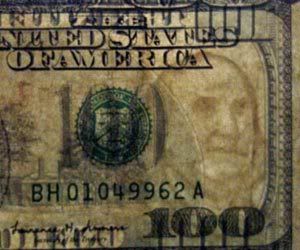 He made an "uh-oh" sound and walked away with the bill. He took it over to a little UV light stand set up by the manager's area and flipped the bill this way and that for several minutes, seeming to wait for something to appear. Then he came back over shaking his head and said, "Nope, can't take it," and handed the two pieces back to me.
He made an "uh-oh" sound and walked away with the bill. He took it over to a little UV light stand set up by the manager's area and flipped the bill this way and that for several minutes, seeming to wait for something to appear. Then he came back over shaking his head and said, "Nope, can't take it," and handed the two pieces back to me.
"Wonderful," I said.
"Take it to the bank and see if they can give you a replacement."
"That doesn't seem very likely," I thought aloud.
"Well, then take it to a liquor store. We've been getting a lot of bad 50s and 100s lately."
I paid with a credit card, picked up my groceries and began walking back home, thinking over the situation.
I should've spent it at that cafe. That girl in her young 20's never would've snapped the bill, it never would have broken and she never would have put it under a UV scanner.
But someone there might have gotten in trouble when it was found out the bill was no good. But what were the odds of that? I didn;t know the bill was bad. It looked pretty damn convincing. Just how many of those bills I got from that guy were counterfeit anyway? I'd been spending them all month. I wonder if he knew his bills were counterfeit. Maybe he didn't. Maybe this was the only one.
Should I try to tape it together and use it somewhere else? Just get rid of it!
But inevitably, someone is going to discover, just as the Alberton's guy had, that the thing was a fake. And then someone will be out a hundred dollars.
I could give it to a homeless person I thought. If it worked for them, great. But there's the same problem. They take it somewhere and it gets found out. (What shopowner will accept a torn hundred from a homeless person without checking it out?) Or, the shopowner takes it and they have to eat a hundred dollar loss later. Or someone else further down the line does. It always comes down to that. Someone will have to eat a hundred dollars worth of shit.
Well, fuck it. It might as well be me, I thought. There've been times in my life when I've needed a hundred dollars a whole lot worse than I do now.
So then. What to do with it? There was always the chance that a bank or government agency MIGHT give me a legit bill in exchange for it. I decided to check the website of the US Treasury.
In fact, the Treasury website has some interesting pages devoted to the subject of counterfeiting. Apparently, the Secret Service was established in 1865 to combat counterfeiting, which had been in practice since the British used counterfeiting to devalue the currency of the "Continental" during the American Revolution. Counterfeiting continued through the Civil War, when over 1600 state chartered banks printed their own unique currencies, "making it difficult to detect counterfeit bills from the 7,000 varieties of real bills. " [- from SecretService.gov)
The Secret Service did not officially begin protecting the life of the President until 1902, although they began informally watching over President Grover Cleveland on a "part-time" basis in 1894. I'm not sure what that "part-time" thing was all about, but once McKinley was assassinated in 1901, it was gradually eased on to their roster of duties, even extending to the President-elect in 1908.
In this era, President Theodore Roosevelt transferred 8 Secret Service agents to the Justice Dept. This was the beginning of the modern FBI. Over the next 40-50 years, the Secret Service's criminal jurisdiction expanded to the investigation of espionage and the protection of former Presidents and family members (spouses until death or re-marriage, children until age 16).
Further attacks and assassination attempts extended the protections of the Secret Service to Presidential and VP candidates and foreign diplomats and dignitaries. The office was continually subdivided and renamed and their jurisdiction was redefined, although it was usually directed along the lines of protecting the lives of people in public office or investigating fraud. Today however, the Secret Service has been folded into the Dept of Homeland Security, so they are now also the executors of the Patriot Act.
All of this, in addition to the following:
Please Note: There is no financial remuneration for the return of the counterfeit bill, but you will have pride in doing the "right thing" to help combat counterfeiting.
... ultimately led me to question the wisdom of inviting the Secret Service over for tea. I began to think that whatever I chose to do about the situation, it was essentially costing me $100. Although it might be cool to meet a real live Secret Service agent, if only so I could write about the experience, it might actually NOT be cool. For instance, the paranoid part of me reasons, what if contacting them casts suspicion on me? I prefer not to be noticed by any agent in charge of administering the Patriot Act. Anyway, I've learned some interesting trivia about US currency and the Secret Service that I would not have looked into otherwise.
And it only cost me $100 !
I pass the savings along to you.
What to do if you suspect a counterfeit
Fun Money Facts! From the Bureau of Engraving and Printing
Know Your Money - Interesting Facts from the Secret Service website
A History of the Secret Service, as told by the Secret Service
Saturday, November 18, 2006
War-walking and Midnight Riding
Got a new macbook last weekend. Decided not to fork out big bucks for top-shelf machines anymore. I always end up unloading them a few years later for pennies on the dollar, and the base models have enough kick to do the tasks I give them.
I love the portability of this thing though. I never thought I'd be a laptop guy, and it's true, my fingers are rather more clumsy on this little keyboard than they are in my online bay at work, but at least I can be out, instead of cultivating the "edit-bay suntan."
So, my new obsession is something known as "war-driving," I guess. Part of my motivation for getting the laptop was knowing that they came with Airport wireless network gear. But as it turns out, there are very few places where you can pick up free wi-fi (the public library, a block from my apartment, happens to be one of them, which is great when they are open). Never one to be defeated so easily, I began reading up on ways to gain entry to password-protected wireless networks. I've heard so many stories of people who do not subscribe to hi-speed internet being able to log on with their Airport-enabled Macs, but I guess they live near unprotected networks... all of my neighbors seem to be a bit more savvy - or they hired the Best Buy "Geek Squad" to configure their service.
Well, like most other things that you are not supposed to do with your computer (such as illegal downloading, duplication of copyrighted media, etc), it seems that where there is a will, there is a 16 year-old Norwegian kid with a way. So I got my hands on a freeware program that scans for wireless networks and reports back on whether they are protected or not. For the time being, it works great for finding hotspots where I can jump on, but as yet, it is useless to me for password lock-picking. Am I painting an unethical portrait of myself? Does this make you uncomfortable, reader? When I was information-gathering, I hit up a programmer who is a classmate of mine in Japanese. The topic got him all red in the face and he told me he couldn't help me. "For ethical reasons, or technical ones?" I asked him. "Both," he replied.
I can't really explain the draw for wanting to do something you are not supposed to be doing. I think it's a basic character trait. I guess everyone has that line drawn nearer or further down-field. I don't feel like such a rotten human for wanting to surf the internet for free, I just don't feel like forking out the cash anymore, and I want to know how this stuff works. I think that's the driving motivation for me more than anything else. Anyway, the "sport" of cruising around, scanning for open networks is referred to as "wardriving," but since I am not so dedicated that I want to go burning gas all over the city and mapping hotspots to GPS data as the real nerds do, I call my modest habit "war-walking." It consists of walking out of my building, powering up my laptop and starting a scan, stopping about three doors down once I've found an open network, and sitting on the curb to surf away, while neighbors come and go, giving me funny looks. I'm actually semi-ashamed of being so cheap.
The other nocturnal weirdness I got into recently was participating in Midnight Ridazz, a bike collective not unlike Critical Mass, that meets up a few times a month for night rides throughout the city. Anyone can join, and any "member" can organize a ride. I first became aware of them driving back from a Friday night Japanese tutoring session in Little Tokyo, when I was intercepted by mobs of bikers huffing up Vermont. I tried to shout an inquiry out the window at them, but I think they assumed I was fucking with them, and I was ignored. Someone told me the name of the group later and I found them on the internet and decided to join an upcoming ride. 
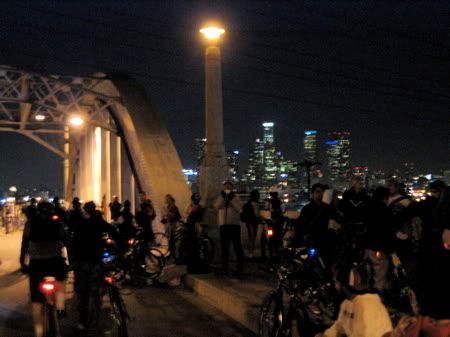
The ride I joined was called "Noche de los Biciclistas Muertos," and was a Dia de los Muertos-themed ride with riders painting their faces like skulls and mounting skeletons on their handlebars. It was a lot of fun, bringing back a lot of my enthusiasm for street riding. I had not been on my bike since I was a fulltime student at UCLA, when it was my main transportation, but cruising deserted streets at night is a very liberating feeling. The ride was about 22 miles I hear, and the route took us past a couple of graveyards. We stopped on the Whittier Blvd bridge for a moment to listen to tunes that someone was pumping out of a trailer-carted stereo system (Oingo-Boingo Dead Man's Party, anyone?) and someone set off some fireworks. It was an oddly beautiful scene: the downtown skyline at night, lights glinting off the LA River, 800-900 bikers hovering above the river on the bridge, fireworks popping over our heads. I was a bit out of shape ( embarrassingly apparent when I was gettin' smoked by cute girls in ponytails passing me on the uphills ), but the cool night air and the scenery made my post-ride butt pains and leg aches worth it. I love the kind of anarchic spirit of events like that. We met at Griffith Park, right near my apartment, and there were so many riders it took a good 20 minutes (!) just for all of us to make the left hand turn out onto Los Feliz Blvd. It's not so much that I get a kick out of inconveniencing drivers, but there's just a wild spirit to it that's made even better by all the customized bikes and zany outfits. There's so many people, most couldn't possibly know each other, but everyone has the same idea of weird good fun.
In a very short time it seems, the idea of Midnight Ridazz has grown from a few die-hard bike enthusiasts to rides that draw over 1000 people. Maybe it is like anything else in LA - it's something hot with a short lifespan. I often think that people here will get in line wherever there's already people standing (think Pink's Hotdogs). I'm not even sure how often I plan to return to it. But it's interesting how quickly Midnight Ridazz has spawned offshoot and copycat groups. Hell, I don't know, maybe they are an offshoot of something else. It's just something that seems to have caught on. An interesting little item for the metrobloggers, like me. I guess.
Until I get Photoshop running on the Macbook, I can't pst any images to the web. So, for now, go to the Midnight Ridazz site for images of the Noche de los Biciclistas Muertos. They have video too.
Tuesday, November 07, 2006
Infiltrating the DGA: The Donner Cut and My Dinner with Ilya
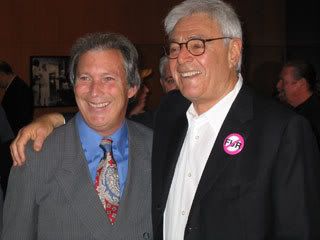
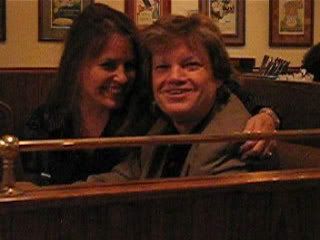
On the left stands Director Richard Donner at the screening for his long-awaited version of Superman II. On the right, the impish Producer blamed for keeping this film from public eyes, Ilya Salkind.For reasons I should probably not reveal, I was a guest at the industry-only screening of "Superman II: The Richard Donner Cut," at the Director's Guild Theater this past Thursday night.
I'm not a religious Superman or comic book fan. I simply got myself involved several years ago with a crazy bunch of people in their passionate attempt to convince Warner Bros. to unvault some missing reels of footage that were rumored to exist. There are detailed accounts around the web of how that footage came to be "lost" and why there are now two existing versions of Superman II, so I won't recount the story. But as an obsessive film geek, hearing the unusual production history of the firing and hiring of directors, the re-writing of the script, and the elimination of Marlon Brando from the final edit refreshed my interest in the film as further documentation of Hollywood's madness.
 The invitation, and the film's existence, felt like a vindication of my clandestine group's efforts, although probably very little credit is attributable in our direction. Nevertheless, we were allowed in, wearing suits and ties, to mingle freely with the likes of Richard Donner, Bryan Singer, and other cast and crew members from both feature film franchises.
The invitation, and the film's existence, felt like a vindication of my clandestine group's efforts, although probably very little credit is attributable in our direction. Nevertheless, we were allowed in, wearing suits and ties, to mingle freely with the likes of Richard Donner, Bryan Singer, and other cast and crew members from both feature film franchises. With the recent proliferation of "Director's Cut" DVDs, there are increasingly more films for which multiple versions exist, although it is rarely the case that the different versions are drastically different . Often, the "director's cut" is merely the re-insertion or extension of a few trimmed scenes which were lost for the sake of a kinder MPAA rating, or for the sake of pacing, etc. It has seldom been the case that a studio or producer has assumed complete creative autonomy and delivered a film that is radically different from what was scripted and shot. One example is the Japanese film Gojira, which was completely reformulated and released in English as Godzilla, King of the Monsters, with new scenes filmed with Raymond Burr and a totally different storyline (aside from the basic premise of a giant lizard crushing Tokyo). A new DVD which pairs both films is a perfect demonstration of Lev Kuleshov's first experiment in film montage - artificial landscape. A commentator on Godzilla, King of the Monsters notes that audiences were unaware that the film was different from what Japanese audiences saw, and the film was admired for it's authenticity in Japanese casting and Japanese set creation. Raymond Burr, it was thought, had been flown to Tokyo for the filming, when in fact, all of his scenes were shot on a cramped stage at a low-rent studio on Vermont Av. ( I hoped to find the studio, since I now live just off of Vermont, but found out that, like many other sites of historical significance in LA, it was torn down years ago).
The next film I can think of which falls into this odd category is Terry Gilliam's Brazil. It too has been released on a great DVD from Criterion which clearly documents the studio's interference with the film and offers two versions to the viewer for comparison.
And then there's Superman II. The backstory to this one seems to have been common lore to any self-respecting film geek; in fact, it is mentioned on the Godzilla commentary as one of the few other examples of an alternate version of a film existing, although, at the time it was not known whether it would ever see the light of day. Most of the fans seemed to be content with the idea of just seeing the raw footage. Apparently, it existed and somewhere buried among it was a performance by the late Marlon Brando. There were photographs which roughly illustrated scenes from the original script, and all of these artifacts had been shared over the magic of the internet for years, giving fans a chance to reconstruct in their heads what Superman II would have been like in a parallel universe.
Finally, due to a confluence of recent events - the revival of the Superman film franchise, the alignment of the planets, and some would say the emergence of a fan-edited reconstruction of the film using bits of "lost" footage culled from international TV broadcasts, Warner Bros and Ilya Salkind and the other powers that be agreed that there were tremendous profits awaiting them should they put aside past differences and allow a new cut of Superman II to be released into the world. And so Donner's sometime editor, Michael Thau, took on the job of patching together a new cut of the film, after 20-some odd years, following the original script and using footage that Donner had shot before he was fired.
Although the DGA theater was mostly filled with industry people (Joe Dante sat directly behind me, Richard Donner and Bryan Singer off to my left, Margot Kidder and Brandon Routh behind them), there were some covert fan infiltrators, like ourselves, peppered throughout the crowd. The sense of anticipation ran through them like electric current, causing nervous twitches and excited bursts of energetic gab. When the MC finished his announcement of the film, a guy in front of me tensed himself inwards, hissing "YES!" in a scream of catharsis that he self-consciously tried to keep from echoing off the theater walls.
The film itself was a bit of a patchwork. There are completed scenes which were lifted unaltered from the theatrically-released Superman II. There were new scenes which were completed with rough visual effects work and/or body double shots. And there was at least one scene which was completed with the only existing footage available - two screen tests of Chris Reeve and Margot Kidder. Even in an industry screening, there were people in the crowd who expected the polish of a finished film, not a historical blueprint; and so, there were snickers at some of the rough FX shots and at Chris Reeve's inconsistent hairstyle across cuts. I was bothered more by gaps in the narrative logic than bad continuity, but I refuse to critique it as a movie because I don't really feel that it is one. For all the money that was spent putting these pieces together (and I don't think it was much), it is really just a chance to see the missing footage that fans were dreaming about all those years.
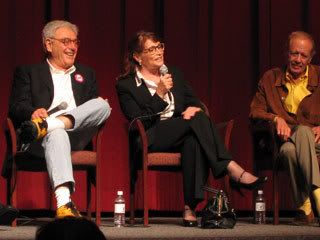
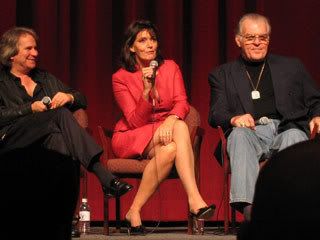


After the screening there was a panel discussion with Donner and other crew and cast members. Donner seemed content with the film and vindicated at seeing his vision on screen, which is interesting since I think his involvement was mainly to critique Michael Thau's editorial work, rather than play a hands-on role in shaping the cut and re-shooting. Truly, with the deaths of the two actors playing the story's central characters and twenty-plus years of age on everyone else, there was little that could realistically be done in terms of re-shooting. But I think he was perhaps slightly more ambivalent towards a re-edit than say, Terry Gilliam was towards restoring his vision of Brazil. That may have to do with the fact that Terry Gilliam actually shot and cut his version, and saw it with his own eyes before it was shredded to pieces under the supervision of Sid Sheinberg. At any rate, Donner says he now feels relieved that it exists in this "restored" form. Audiences will take away what they will.
After the screening, my friends and I went across the street for a bite only to have Superman's producer, Ilya Salkind, seated with his guests directly across from us. He's a crazy guy. He told us to say that.
"Tell them he's a crazy fucker, because I am!" he giggled in his multi-lingual accent, sipping a beer.
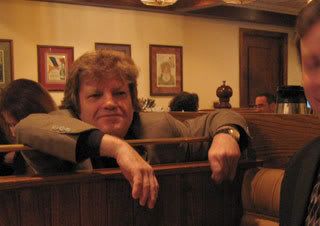
Ilya Salkind proved quite genial and loquacious, hanging over the divider between tables at Greenblatt's to tell his side of things.
We all looked up in disbelief as he walked in and sat at a table near us, but he engaged us directly in conversation, saying first that we looked like the Reservoir Dogs (all of us dressed in suits), and then asking if we were Hollywood consultants. When my friends explained that we were just a group of Superman fans, Ilya's companion decided to quiz us and see if we were "real" fans. "Name three girlfriends Superman had whose intials were all LL." I knew that if I had been alone, the conversation would have ended there, but I also knew that this guy had no idea who he was fucking with. My friends were the real deal. Having passed the test, Ilya cheerfully leaned over the handrail separating our tables and bantered on for at least twenty minutes about the difficulty of working with Donner, his reputation in the media, and his previous attempts to re-edit Superman I & II with Richard Donner into one long movie.
"We were gonna trim all the fat, and that fucking movie would have been like a rocket! Dick was so excited about it, we were jumping up and down, kissing each other."
I don't know whether Richard Donner and Ilya Salkind ever shared so much joint passion over anything that they actually jumped up and down kissing each other. Donner made it rather clear on the panel that he had banished the Salkinds (Ilya produced with his father, Alexander) from the set and that their relationship had ended very badly. Margot Kidder also engaged in a little Salkind-bashing on the panel, and mentioned that her previous on-record outrage at the producers back in the early 1980's had resulted in her part being vengefully slashed away in Superman III. Clearly, history has been kinder to Donner than Salkind. This was Donner's party, after years worth of fan support, clamoring for Warner Bros to release the footage from the vaults. All the celebrating was leaving Ilya feeling a little cold though, and as the night wore on, he embarked on an above-the-belt revenge-rant against Donner and Donner-philia, pausing only for self-congratulatory asides.
"Do you know how many fucking takes he did of that red sun?" Ilya claimed it was in the 40s I believe, though I have forgotten the precise number.
"That's hilarious," one of us responded.
"It's not hilarious when you're producing a movie! What did you think about the boy in Superman Returns having super powers? The love scene in this Donner Cut was edited with that in mind, but it makes no sense! How could he fuck her? He's an alien ! It makes sense in our film."
When Tom Mankiewicz spoke at the panel discussion, he related his initial reluctance to do a comic book adaptation. He went to meet with Richard Donner and found him dressed in the Superman costume. "Just try the costume on, Tom. Once you do, I swear you'll want to do the story," Donner told him. Mankiewicz attributed the film's narrative success to Donner's willingness to "get inside" the story, to accept the fantastical elements as factual and proceed to the emotional heart of it. Whether this view of the story was shared by Salkind I don't know, but he seemed as passionate about the story as any fan I'd ever met, and just as ready to engage with it on his own terms of "realism."
"What did you notice in the original Superman II about the molecule chamber?" he asked, as we were leaving. He had that impish grin again, waiting to trip us up on our knowledge of Superman. "Not this edit, but the original one. What did you see? No fan has ever caught this."
My friend, who has seen the Superman films more times than is safe for one's health, made several attempts to guess at where Salkind was leading.
"No! Wrong! What did you see?!"
Giving up, he finally told us. "His skull! It's his skull!"
We looked at each other blankly.
"He has an alien skull!"
I meekly attempted to follow up the uncomfortable silence with a query for more information. "What was the distinguishing characteristic of the skull?"
"It's ALIEN!" Salkind roared. "Go and watch it! I made them put an alien skull in there!"
As we said goodnight and shuffled off, I pondered Salkind's situation. He was the Judas of Superman. He was blasted by Donner, the cast and crew, the media, and the fans. Although he had initiated the project and put as much sweat into it as anyone, his legacy was as the "ruiner." There was something a little bit sad about the whole thing. Donner being celebrated for a work that is supposed to be "his," Salkind's frustrations with the project growing out of his hands and turning its back on him like an angry teenager, and not least, the fans who would undoubtedly watch the new film and return to the internet to bemoan its shortcomings. For many people, it will always be what it was supposed to be - simple inspirational myth. But filmmaking is such a wierd political, strategic beast to conquer, sometimes the events surrounding the mythmaking take on their own mythic qualities. Those who care enough to do the archeological digging end up sharing the neuroses of the filmmakers, and the whole spectacle can shift focus to new players.
As much as I have sometimes hated being a part of the pollutive cultural fallout of the entertainment industry, the trade-off is being able to swim in these little eddies of minor historic cultural significance. The dramas that unfold here may be of little import on the grand scale of life, but some of these episodes are almost Shakespearean in their parade and bedeviling of pride and passion.
Monday, October 30, 2006
Harlan Ellison, Still Angry After All These Years
DISCUSSION / BOOK SIGNING - Oct. 29 - Skylight Books
Moving to Los Feliz was a mixed bag for me. I've been there for almost a year and I love that I can walk to anything I might need (grocery stores, post office, library, movie theater), but I am also irritated at having to share that convenience with LA's trendy elite. Resistant to the Borg-like mentality which compels LA's scenesters to emulate each other in heroin chic-derivative dress and mannerism, I often feel like an outsider walking the streets of my own neighborhood. As much as I bristle at the rude treatment received from coffee shop waitresses whose minds are on their afternoon auditions, I accept it as the cost of living in a bohemian atmosphere that provides a sustainable ecosystem for places like Skylight Books. I've never lived in any other famously bohemian neighborhoods, like Haight-Ashbury or Greenwich Village, but I imagine they would be stimulating and irritating in similar ways.
I love to visit Skylight. It's not that I can afford to buy new books (I can, but if I indulged in the practice as much as I am tempted to, it would become an expensive habit), but Skylight is one of those bookstores that gets writers like Harlan Ellison to make an appearance, and I love the fact that I can discover events like this on my way home from the supermarket, walking down the street with a bag full of chicken drumsticks and garlic. Beyond that, they are one of those bookstores, which are becoming increasingly rare, into which you can walk and make a discovery, rather than going into Barnes & Noble because you expect to be able to find that classic Ray Bradbury book that you would like to give as a gift, and discovering that it is not stocked because they need the shelf space for John Grisham.
Having written over 1000 pieces of fiction, from short stories to television scripts, and edited numerous anthologies, Harlan Ellison is now one of the American elders of science fiction literature. He's matured into grandaddy status, having outlived Robert Heinlein, Isaac Asimov and Philip K. Dick. He used attract media for his "live" storywriting sessions, where he would sit in the window of a bookshop and type an original story. He wrote the original "Star Trek" episode "City on the Edge of Forever," in which Kirk, Spock and McCoy travel back to America during the Depression, as well as several influential episodes of the original "Outer Limits;" two of which, "Soldier" and "Demon with a Glass Hand," provided the inspiration for "The Terminator." Ellison was recounting this story when I walked in. Apparently, James Cameron almost went on the record in a magazine interview, giving credit for his story to Ellison, but had his lawyers contact the magazine shortly before publication to remove the quote. There was eventually a legal settlement, and Ellison is credited as an "inspiration" in the final credits of the film. Ellison comes across as principled and vindictive. In response to his almost being snubbed out of credit on "The Terminator," he took out a full page ad in one of the trade magazines, reprinting the "inspired by" credit from the film under the title "Exhibit A."
"He thinks his shit don't stink! He really thinks he is emperor of the world or something," Ellison exclaimed about Cameron. 
One thing Ellison is not is modest. He doesn't even give the impression that he would claim modesty as one of his virtues. He sings his own praises, recounts his own accomplishments, and in true geezerly fashion (he's now in his 70s), condemns today's generations for allowing the internet to provide them with a false sense of informed awareness. I can't say I disagree totally with his cynicism, although since no one in the audience was as old as Ellison, I wondered if we were granted special exemption from the uninformed masses by virtue of being in his sage presence. I'm capping on the man a little bit, but I think Ellison has always been a kind of cynical geezer - in the best way - as a critic of media and society, who has been prone to outbursts along the way - over anything from tampering with his work (which includes posting it online without permission, see the legal case against AOL), to making assaults on people in public (various documented cases online, differing circumstances).
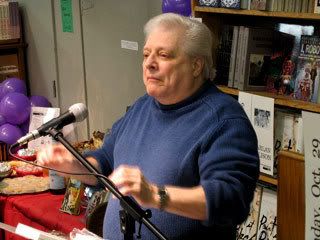
He says he has had quadruple bypass heart surgery and has been warned against having emotional outbursts, "but it happens... everyday." Certainly there is record of him having outbursts in public, and some of those have been dark accounts. I tend to romanticize people with angry, emotional natures, perhaps since I identify so well with them, and I am drawn towards the manifestation of this nature in his work and in certain aspects of his life (being a Hollywood outsider with enough power and contempt for producers to turn them down, participating in the Selma-Montgomery Equal Rights marches). Harlan Ellison, like Terry Gilliam, is the type of personality who indentifies himself as the underdog, and if you identify yourself as such too, there's an instant attraction. (For evidence of my own geezerliness, just review the first few paragraphs). There is a substantial amount of legend surrounding Ellison's brash public behavior that is less than a romantic underdog fable, but I am mostly familiar with him for his writing.
Among those who may only know him for his legend are those who would hire him. Ellison described the process of collaboration between him and the producers of the upcoming "Masters of Science Fiction" series as a back-and-forth game of indecision. The executives wanted Ellison to pick a story. "I have 1400 stories! How the hell do I know what they wanted?" he screamed. "Apparently they have time to be executives, but they don't have time to read." Then he was asked for an adaptation of "Repent Harlequin! Said the Ticktockman." Despite it being a reader favorite (undoubtedly why it was chosen by the execs), Ellison did not feel it lent itselt to a television adaptation. "Why can't something that you like exist in it's own medium?" he begged. It must be a particularly nagging question for a guy who's been so prolific and had so many of his pieces adapted, directly or indirectly, to varying degrees of success. He expressed his amazement that he was not only courted for the series, but that ABC, who was putting up half of the funding for the show, stipulated that their involvement would be contingent on Ellison being attached. If this is not a case of Ellison's ego self-deluding him, it is a nice piece of irony. "There are studios where I am still not allowed to work!" he hollered. "They lay out minefields when I walk on the lot." I guess as you get older, your legend grows, and whether that is owing to the stature of your work, the myths that surround you, or simple longevity, having a reputation for being "difficult" ceases to be a handicap when your name is synonymous with big sales.
I've always found it interesting to see the legends of my own time up close, whether that be James Brown, or Charlton Heston. Whether you love their work or hate it, and however you feel about the individuals themselves, there is some charisma that these people use to cast a spell over millions of people. In his immodest way, he told the room that there were things he could not do and things he was great at. "I can sing well," he told us (apparently he has sung professionally, casually name-dropping that he is good buddies with Mel Torme). "I can do these kinds of public speaking events. And I can write like a son of a bitch." I find it interesting that he excels in two talents, writing and verbal storytelling, which are not always co-occurent, and I can count it as an experience to have heard this son-of-a-bitching writer hold court and charm an audience with his brashness for an hour.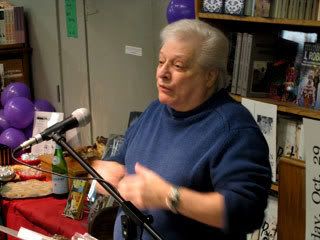
Wednesday, October 25, 2006
宇宙からのメッセージ Message From Space Trailer (1978)
Wow. Youtube truly is magnificent.
I found the trailer for Fukasaku Kinji's Star Wars rip-off "Message from Space," starring Vic Morrow and Sonny Chiba.
Now if only I could find the whole movie...
Wednesday, October 18, 2006
You Always Hurt the One You Love
Haunted George has gotten me going on the virtues of Youtube. There are some truly amazing archival materials to be found, if one has the time to go sifting. I saw a clip of a young Frank Zappa "playing the bicycle" from the Steve Allen show. Haunted George found a great clip of Korla Pandit playing mysterious and exotic sounds on his Hammond organ that he linked to on his Sick blog. I wonder, now that Google has purchased Youtube, if some of these cool videos will disappear due to fears of copyright infringement, etc.
Perhaps.
But in the meantime, here's a cool clip of the Mills Bros. doing "You Always Hurt the One You Love." I never should have let Alberto remove this from his film.
Friday, October 06, 2006
Peter Fuller.
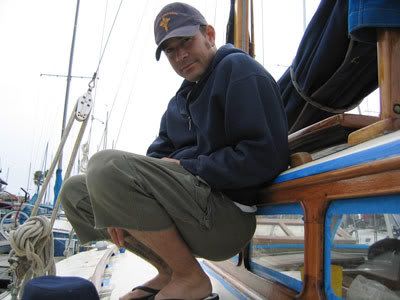
A good friend to a good many people. Went away too soon.
I've decided to share some of my images and memories of him here.
Friday, September 08, 2006
Chicag/no
Labor Day - Just returned from Chicago and Indiana. The Lake Michigan region. Said lake is big enough to fly over in a jet aircraft and not see either side for twenty minutes. It's big enough to look down on from the clouds and see white caps, as one sees when flying over the ocean. It's big enough that in Chicago, they refer to the waterfront as "the beach," and there is sand and surf and seagulls too. For all that size, Toddrick, who lived in Chicago for six years, tells me that in the winter, when temperatures can drop to 40 below, that entire lake will freeze solid and chips of ice can be lifted off of it, sailing on the wind through downtown's city streets. "Great city to visit, hard city to live in," he mumbles.
I traveled to the northern midwest with Richard, Danica and Salomón. Richard has been doing a documentary on Salomón, a painter whose art was being featured in a show at Notre Dame. I didn't know Notre Dame was in South Bend, Indiana. I didn't know I was going to Notre Dame. Some of my pep for the trip had subsided when I found out we would not be spending the majority of our time in Chicago. There's something about the big cities that has always lured me in. San Francisco, New York, London, Tokyo, even New Orleans, although it is not known as the massive metropolis some of the others are. These are places that have layers and layers of human history that no amount of urban renewal can ever completely remove.  Before we could even get off the ground at LAX, we were delayed for about an hour due to some kind of security breach at the airport terminal. No one passed through security during that time. We all just stood outside on the curb in the pre-dawn darkness, while our planes waited empty on the other side. We speculated on the changed nature of air travel and the false sense of security these new measures provided. I wondered why someone could not swallow a condom filled with explosives and find a way to detonate it on board. Drug mules swallow condoms filled with drugs.
Before we could even get off the ground at LAX, we were delayed for about an hour due to some kind of security breach at the airport terminal. No one passed through security during that time. We all just stood outside on the curb in the pre-dawn darkness, while our planes waited empty on the other side. We speculated on the changed nature of air travel and the false sense of security these new measures provided. I wondered why someone could not swallow a condom filled with explosives and find a way to detonate it on board. Drug mules swallow condoms filled with drugs.
We stayed at a hotel on the Notre Dame campus called the Morris Inn. It was nice, comfortable. Although Salomón accurately pointed out that from the outside it looked like a prison (all beige concrete and right angles), inside were pieces of furniture that looked expensive, which always makes people feel like they are getting the best. In the bathroom were hung quaint Irish proverbs - toasts and prayers. The legacy of the Irish is felt strongly throughout the school, although it was founded by a French priest. The driver who picked us up from the airport, a student of politics who was born in Guatemala, recounted for us the origin of the "Fighting Irish" mascot. Apparently, the name stuck after the Irish went to rumble with the Ku Klux Klan, who were attempting to set up a chapter in South Bend.
After we dumped our junk in our rooms I sat outside for moment to enjoy some fresh warm air. There was a bit of tropical humidity, but not enough to make your shirt cling to your skin. Cicadas hummed. The campus is all manicured green lawns and large shady trees.  There was a large dome on campus, topped with what looked like a gold plated figure of Mary, mother of Jesus. Notre Dame. Our lady. Makes sense. There was a building across from a massive football stadium with an arms-uplifted mosaic they called "Touchdown Jesus." Jesus was everywhere. Most of Notre Dame's student body is Catholic. Richard and I took a walk at night and discovered "the grotto," a candlelit stone recess where students came to pray during all hours of the night. The quiet flickering candlelight was serene, a marked contrast to the nights of screaming and beer drinking I remember from UCLA.
There was a large dome on campus, topped with what looked like a gold plated figure of Mary, mother of Jesus. Notre Dame. Our lady. Makes sense. There was a building across from a massive football stadium with an arms-uplifted mosaic they called "Touchdown Jesus." Jesus was everywhere. Most of Notre Dame's student body is Catholic. Richard and I took a walk at night and discovered "the grotto," a candlelit stone recess where students came to pray during all hours of the night. The quiet flickering candlelight was serene, a marked contrast to the nights of screaming and beer drinking I remember from UCLA.
Notre Dame has an Institute for Latino Studies and a guy named Gil Cardenas is the Director of it. Although there are ethnic studies departments at most universities, I wondered if Notre Dame was making a special appeal to potential Latino students (known statistically to be predominantly Catholic), as they may have done in years past with America's larger population of recently immigrated and Irish Catholics. Gil's an interesting guy. He lives in a massive house that seems to keep expanding into more rooms as you travel through it. It is just outside of the campus and sits on the bank of a calm green river that reminded me of Tom Sawyer Island in Disneyland. Every inch of interior wall space is covered in art; above bookcases, under stairwells, in bedrooms, in bathrooms, above the toilet, art was hung. My first and second nights in South Bend, I moved about the rooms of his house, following the dozen-plus artists who had gathered for the show with a video camera and making them slightly uncomfortable.
It has been a long time since I have done any shooting. It was a nice change of pace, scenery, action, mood. Not the sunless edit bay of the Cimarron Group, air-conditioned to 70F everyday. I didn't mind playing paparazzi, it was good exercise, but there was very little I could do with the camera on or off that would make me feel like more than a functionary, a walking lens.
I know nothing about fine art and my attitude towards it tends to be ambivalent. There is fine art that I can admire and relate to viscerally, but the scene surrounding it seems to be about qualifying good art over bad for the purpose of creating value. I hate the snobbishness of gallery spaces and I despise the idea of people gloating over their precious private collections. Gil seemed to have a real passion for all of his art though, and his repeated attempts to get artists to sign books or do sketches for him stemmed from both his nature as a curator and his desire to create and maintain personal relationships with all the artists he admired.
The artists and work gathered for the show were all quite different from one another. The show was titled Caras Vemos, Corazones No Sabemos: The Human Landscape of Mexican Migration, so it all focused on immigration or the immigrant experience in the US. I was a little too overwhelmed by new faces and information to remember names, but I saw video installations, photography, traditional paintings, and silkscreened art. Some of the artists made three-dimensional sculptures and one created a mural out of twelve panels which were printed from woodcuts. Another guy made masks out of mirrors that were intended to scramble the wearer's facial features with those of the person who looked at him. 
Richard chats with Marcos Raya.
Marcos Raya's work caught my eye. One of three men in the show whom I never saw without his hat, Raya had a lean and nimble figure. He spoke seldom, seeming to reserve speech for comments which were necessary or worthy. He was impossible to gauge; after looking at his work, I had no idea how to begin a conversation with him. Regardless of the fact that he was fluent in English, I found myself wishing I could make conversation with him in Spanish, feeling that might help bridge the intellectual chasm between us. I suspect I know less Spanish than Japanese these days, which doesn't say much for my capabilities in another language. I felt out of his league, even on my linguistic home turf. His art is surreal and incorporates a lot of imagery of technology, seemingly gone haywire. He paints himself into some of the images, and other times incorporates himself in a much more unusual "first-person" perspective, showing the inside of a skull and the view through a pair of eye-sockets. He's got a Fellini-esque fascination with asses, bulbously distorting the naked shapes of women and driving foreign technological shapes into the flesh of his human subjects. Sometimes his colors are bright reds, blues, greens, and sometimes his paintings look as though they were made with ash.
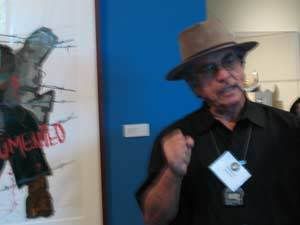 Malaquias Montoya gave off a much more approachable, almost grandfatherly vibe. I guessed him to be in his mid 50s, but he had that mellowed, good-natured air that people usually ease into once grandkids appear in their lives. Never once did I see Mr Montoya without his fedora, or a paint encrusted stopwatch which he hung around his neck. Shaking hands with him was like shaking hands with a tree; his skin was calloused and weathered from years of working with brushes and chemicals. His smile was carved by deep lines in his face. One never expects to find brothers in a place far from home, but I learned that Montoya had lived for several years in my hometown of Oakland, and taught at the California College of Arts and Crafts. I was introduced as well to his son, Maceo, whose work was also featured in the show. It was interesting to see the artistic lineage being passed down, the same way a carpenter or mason or other craftsman might pass on their knowledge and skill to a son or an apprentice. Malaquias' silkscreened image, UNDOCUMENTED, was chosen to represent the show. On the return flight, I flipped through a book of his images, based on the theme of capital punishment. I admired him for his idealism, which is nothing more than rational thinking, but so uncommon. I recently watched "Gangs of New York" and recalled a scene in which four men were pulled from the streets and hanged to create a political distraction and the illusion of civil control. I remembered an argument I had with my family over the execution of Stanley "Tookie" Williams, and how plain it seemed to them that vengeance was the right answer to crime. Malaquias' paintings depict the graphic deaths of several hanged, electrocuted and poisoned convicts, not simply to garner sympathy for their suffering, but to question the humanity of the perpetrators. Making that argument verbally, I could not do anymore than have heads shaken at me, and I doubt whether these paintings would make their way into many people's homes. I sympathized with Montoya's placement of his principles above his concern for offending an audience's aesthetic sensibilities.
Malaquias Montoya gave off a much more approachable, almost grandfatherly vibe. I guessed him to be in his mid 50s, but he had that mellowed, good-natured air that people usually ease into once grandkids appear in their lives. Never once did I see Mr Montoya without his fedora, or a paint encrusted stopwatch which he hung around his neck. Shaking hands with him was like shaking hands with a tree; his skin was calloused and weathered from years of working with brushes and chemicals. His smile was carved by deep lines in his face. One never expects to find brothers in a place far from home, but I learned that Montoya had lived for several years in my hometown of Oakland, and taught at the California College of Arts and Crafts. I was introduced as well to his son, Maceo, whose work was also featured in the show. It was interesting to see the artistic lineage being passed down, the same way a carpenter or mason or other craftsman might pass on their knowledge and skill to a son or an apprentice. Malaquias' silkscreened image, UNDOCUMENTED, was chosen to represent the show. On the return flight, I flipped through a book of his images, based on the theme of capital punishment. I admired him for his idealism, which is nothing more than rational thinking, but so uncommon. I recently watched "Gangs of New York" and recalled a scene in which four men were pulled from the streets and hanged to create a political distraction and the illusion of civil control. I remembered an argument I had with my family over the execution of Stanley "Tookie" Williams, and how plain it seemed to them that vengeance was the right answer to crime. Malaquias' paintings depict the graphic deaths of several hanged, electrocuted and poisoned convicts, not simply to garner sympathy for their suffering, but to question the humanity of the perpetrators. Making that argument verbally, I could not do anymore than have heads shaken at me, and I doubt whether these paintings would make their way into many people's homes. I sympathized with Montoya's placement of his principles above his concern for offending an audience's aesthetic sensibilities. Much discussion about the purpose of art and the ways to connect it to an audience was had during the conference which followed the exhibit. Particularly since this show focused on Chicano art, which is by nature political, there was a deep concern with how to engage the public in the issues addressed by the show. Jose Limón of UT Austin made the valid critique that a museum show, with limited public accessibility, was not an effective way to engage people in political ideas. I thought that the inclusion of a Lalo Alcaraz "L.A. Cucaracha" comic strip panel came closest to representing art from a public sphere that people could easily relate to. Fine art does not seem to me to be a part of many peoples' modern lives. I think graffiti and stencils and Xeroxed posters and other street art that augments/alters/vandalizes advertising is the most interesting type of "fine art" going right now. It addresses some of the same ideas that the artists in this show are concerned with, but it makes itself visible in places where people already are, it does not wait for people to find it. And it uses a familiar visual language. Some of what you find on the street is just self-promotion - many people are branding themselves with an image the way Shepard Fairey did with Andre the Giant. But other people are coming out of the advertising world and using the visual language of advertising, which is common to everyone, to tackle political issues, even if their message is not always totally clear. I remember distinctly the wave of iRaq posters featuring Abu Ghraib silhouettes that lampooned the Apple iPod campaign. It would be cool to see a show that tracked down more samples of this kind of political art.

Salomón Huerta stands before an early piece in the home of a collector.
Richard observed that this show was attempting to "canonize" Chicano art within the "mainstream" world of fine art. Salomón Huerta had some interesting points on this. He appears to have carefully managed his career to avoid being "ghettoized" in an ethnic artist category. He's achieved fame for dealing with ethnic identity uniquely, by painting the backs of subject's heads. Where most Chicano artists seem to qualify themselves as Chicano first, Salomón seems to want to achieve notice simply as an artist. He struck me as an incredibly smart guy who kids around a lot and projects a kind of casual but super-confident indifference, like my old friend Joaquin, but with the chops to back it up. There has been plenty written already about his heads and suburban houses, so I won't try for a critical summary here. My sense was merely that, behind the wisecracking exterior, there was another kind of cool - a patient, watchful eye, as observant of color as of behavior. I realized with Salomón and some of the others that they've done art most of their lives, and whatever art you do, that level of practice and discipline nurtures highly developed thought, because it is a constant meditation on oneself and one's surroundings. I never quite viewed myself as an "artist" and I think being in the company of these guys made that distinction in self-perception and commitment apparent.
Lastly, there was Chicago. I finally made it there for a day of roaming around and to take in the Cubs against the Giants at Wrigley Field. I've now repeated to various people that the Wrigley Field experience is a must, not just for baseball fans. I am not a sports fan of any kind, but the flavor of that field is distinct and historic. It's situated in a neighborhood of brownstone apartment buildings, from the roofs of which people gather to watch the games. The field is one of the MBA's smallest, which supposedly accounts for more balls sailing out of the park. We saw Barry Bonds rock one out, around the 4th inning, to mixed cheering and boos. The Giants took the game 7-4 (although we left in the 8th, when we thought it was over at 4-3).
From Wrigley Field we moved on to Millennium Park, a new development on the lake shore which opened in 2004 and purportedly cost in the neighborhood of $500 million. Taking in the public art pieces, it was easy to see where that money was spent. One of the favorite pieces was referred to as "the bean," and was a chrome kidney shaped lozenge, with enough of a curve for several dozen people to pass under at once. Because of the distorting reflections, I smacked my head up against the side of it while trying to pass under, haha. Like a carnival fun house mirror, people loved just standing in front of it, taking pictures, doing strange walks and dances, or just smiling and pointing at themselves and each other. I was slightly more impressed with a piece a few hundred yards away. It was two towers of video screens facing each other, projecting images of faces with pursed lips. After about fifteen minutes, water shot forth from the pursed lips in a thick stream like a suspension bridge cable while naked kids dodged and danced underneath it. It was such an unusual sight and people seemed to be having so much fun splashing in the water around it. There was also a massive outdoor public theater designed by Frank Gehry that bore quite a strong resemblance to LA's Disney Concert Hall. Gehry also designed a winding overpass bridge that pedestrians could walk and park themselves on, suspended over six lanes of downtown traffic for stunning views of the city's skyline. There were public gardens filled with grasses from around the world, from which a small rabbit bounded out and nibbled on the lawn at the foot of Gehry's bridge. There was a large grassy field where a free jazz festival was being held and beyond that, the massive water fountain I remember from the opening credits of "Married... With Children." There were museums everywhere, all of which were closed, it being the Sunday of Labor Day weekend. As we walked downtown, Danica pointed out a large sculpture by Picasso, sitting in a public square. The guys were somewhat skeptical about it being a Picasso, but Danica was the only one of us who had been to Chicago before, and taken a guided tour of downtown landmarks no less. The sculpture was large enough to walk on, which Richard and I did. Salomón seemed a little disturbed at the idea of skateboarders busting ollies off a Picasso.
Richard suggested we try a restaurant that his friend had given the glowing recommendation of "best Mexican restaurant in the US." So we went in search of it. Along the way, we found a massive drawbridge which had been left abandoned in the vertical position. It stood, arm upraised at the elbow, at the base of the Chicago Sun Times. It looked as if it might crash down at any moment. The river winding through the city reminded me of Tokyo and the ferries that one could take to get around the city there.
Even at 9 or 10pm, there were large numbers of people on foot in downtown areas, walking under skyscrapers, near L-trains, past storefronts and restaurants, outside of jazz clubs and blues bars. I decided I needed to come back to see the rest of this place: all the art inside the huge museums, all the old buildings, all the historical landmarks, all the unique neighborhoods, all the old bars, hear the music, ride the trains.
Yeah, it's definately on the list of places to return to.

Tuesday, July 25, 2006
Polish Movie Posters ( ...Are Cool... )

Polski Governator circa 1984
I actually had this idea myself, when I was frequenting the gym. Why are those treadmills and ski machines plugged in, drawing power? Why not reverse the flow and let those hot young girls in their 20's pump their energy back into the grid? As one dirty old man said to the other, if we could bottle that heat, we'd be rich.
So on to the Polish movie posters.

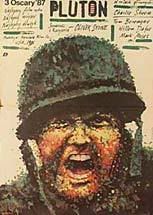




Sampling of Polish movie poster art from the late 1960s to the 1980s. From L-R top to bottom: Apocalypse Now, Platoon, In Cold Blood, Playtime, Alien, and The Phantom of Liberty.
I signed up as a volunteer with the American Cinematheque. I've been trying to get myself a little bit more involved in community affairs. Being a lousy manager of my own time often makes that extremely difficult. But the Cinematheque is one of those places that has exposed me to too much good stuff, and I owe something, however small, in exchange for all the great films I've learned about from their programming staff. So this month I searched the internet for movie posters to upload to fandango.com, to represent the films that are programmed in August. Found some cool old stuff for the Roger Corman retrospective, and old Elvis movie poster art is fun to look at it.
One of the great resources on the net for old movie poster art is posteritati.com. They specialize in film posters for collectors and have a bunch of posters for foreign films and foreign posters of American films. While browsing, I began to notice that almost all movie posters from Poland resisted the typical Hollywood marketing strategies that have been inherited in most other parts of the world. Polish movie posters, first of all, are almost always painted artwork, rather than photographic art from special photo shoots. Also, in concept, they do not strain themselves to "sell the star," by showing his stupid face. Instead, they draw their concept from the theme of the film, resulting in great expressionistic (or impressionistic?) subjective variations on the content of the movie.

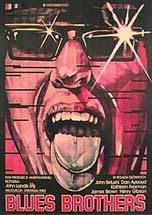 I have no idea how many Polish artists were active in the film advertising industry during its peak, or during the duration represented by posteritati's collection. But the art seems highly individual, as though there were no agency art director, no creative meetings, no client on the phone to dumb down the concept or request that it look more like the poster of last year's Oscar winner. These are designs where the painter seems to have had full control.
I have no idea how many Polish artists were active in the film advertising industry during its peak, or during the duration represented by posteritati's collection. But the art seems highly individual, as though there were no agency art director, no creative meetings, no client on the phone to dumb down the concept or request that it look more like the poster of last year's Oscar winner. These are designs where the painter seems to have had full control. It is interesting to see how they interpreted huge Hollywood blockbusters, movies that were marketed here with bright colors, big stars' faces, bold letters. The Polish art is totally indifferent to the salary of the actor who was in the movie, or the box office draw of the name "Spielberg." In the case of Back to the Future, it's as if the artist knew the movie was a pointless piece of shit and could not be bothered to make any unreasonable fuss over it.

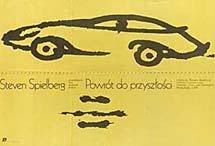 In more than one instance, looking at the Polish movie art for Hollywood films makes me curious to see what a Polish version of those same films would have been like. Of course, with films that have interesting thematic content, the artist grabs hold of it and produces a bold, effective design that often trumps the design from any other country. What's cool about posteritati's search engine is that you can search by film title or just by country, so after pulling a huge list of Polish posters, you can select one title and compare it to other art from around the world. This is exactly how I discovered that there was a consistent style to the art from Poland. If I knew more about art and painting, maybe I could use vocabulary to describe it more effectively or understand its relationship to the rest of Polish or Eastern European art. But as it is, I'm just a film buff who finds it extraordinary, and if I had the disposable wealth, and the mind to spend it on a collection of stuff, I would doubtless be buying Polish movie art.
In more than one instance, looking at the Polish movie art for Hollywood films makes me curious to see what a Polish version of those same films would have been like. Of course, with films that have interesting thematic content, the artist grabs hold of it and produces a bold, effective design that often trumps the design from any other country. What's cool about posteritati's search engine is that you can search by film title or just by country, so after pulling a huge list of Polish posters, you can select one title and compare it to other art from around the world. This is exactly how I discovered that there was a consistent style to the art from Poland. If I knew more about art and painting, maybe I could use vocabulary to describe it more effectively or understand its relationship to the rest of Polish or Eastern European art. But as it is, I'm just a film buff who finds it extraordinary, and if I had the disposable wealth, and the mind to spend it on a collection of stuff, I would doubtless be buying Polish movie art. 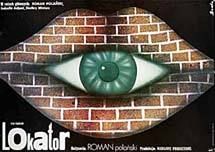

Great Polish art for a great Polish film director. Polanski's Rosemary's Baby and The Tenant.
Go to posteritati's search engine and select POLISH from the POSTER NATIONALITY drop-down menu.
While you're at it, why not go to the Cinematheque's calendar and see what cool movies are showing this month?
Monday, June 12, 2006
Capote on DVD
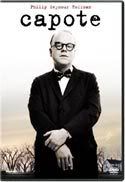 I never even noticed that Capote had come out on DVD, but I should have, since I did some work on it. I no longer really work with the DVD people at Cimarron, but every once in awhile I am called back into their service. This little task was actually kinda fun, and unusual for me. (I think the studio normally takes care of it). Sony asked us to break the film down into 28 chapters for the DVD - to identify the break points, name the chapters, and select an appropriate image to represent each chapter on the DVD menu. Somehow this job got passed to me. I kinda enjoyed it. This was all just before the Oscars, so it was even a little fun to think that the film might be a Best Picture winner. Anyway... for anyone who has ever wondered... yes, there is a person whose job is to sit and watch the movie, decide where to put the chapter breaks, and choose catchy chapter titles and images for the DVD menus. On Capote, I was that guy. Yippee.
I never even noticed that Capote had come out on DVD, but I should have, since I did some work on it. I no longer really work with the DVD people at Cimarron, but every once in awhile I am called back into their service. This little task was actually kinda fun, and unusual for me. (I think the studio normally takes care of it). Sony asked us to break the film down into 28 chapters for the DVD - to identify the break points, name the chapters, and select an appropriate image to represent each chapter on the DVD menu. Somehow this job got passed to me. I kinda enjoyed it. This was all just before the Oscars, so it was even a little fun to think that the film might be a Best Picture winner. Anyway... for anyone who has ever wondered... yes, there is a person whose job is to sit and watch the movie, decide where to put the chapter breaks, and choose catchy chapter titles and images for the DVD menus. On Capote, I was that guy. Yippee.
Tuesday, June 06, 2006
My Experience with Habitat for Humanity, or How to Properly Celebrate the Birth of the Antichrist


I had been meaning to volunteer for Habitat for Humanity for months. At some point I realized that there were areas of Los Angeles (and probably every other major American urban center) that could reasonably qualify as third-world. In addition to that, I observe on a daily basis how much personal wealth is generated for people who do not contribute anything valuable to society. OK, forget about contributing anything valuable to society... some people take home huge salaries without even knowing how to do their goddamn meaningless jobs.
I work in the movie advertising business.
Working in such an industry makes one observant of the fact that today's world is driven by so much theoretical wealth, theoretical exchange, theoretical "goods."
Working in my corner of the world, it is very hard to feel that you are doing anything of value with your life. It is a challenge to feel personally invested in campaigning for a product that you do not believe in - whether that product is a movie or Arnold Schwarzenegger's campaign for governor. My job consists of trying to dazzle people and convince them that they want something that they really don't need (and would be better off without).
Since I feel that way about it, it seems weird to me that I am paid to do this work. Surely, it is not to the benefit of society to have advertising, especially when it distorts the truth (as all advertising does). Not only is this work not beneficial to society, but I have observed a large amount of bloat in this industry - grossly over-inflated salaries, positions which could be entirely eliminated. It's led me to believe that this is widespread in the modern world. Most of us who live comfortably in the world do not put in as much work (physical or otherwise) as those of us live poorly. Comfortable jobs come with less supervision, more freedom, more autonomy, less efficiency, more waste. In addition, most of us who live well in the world make our living by producing goods or services which are of little or no practical value.
It's so odd to my naive mind that immense wealth can be generated by such a system.
I suppose it feels good to know that we have specialized skills and college degrees, and that the jobs we do could not be done by just anybody. But we're not teaching anything valuable. We're not producing food, or providing water. We're not caring for the sick or dying. We're not addressing causes of violence between people, or reducing damage to the environment. Nope, we here in the movie advertising business are just pumping out more junk for consumption and disposal.
Humankind has hardwired instincts to do physical work. We have always fought those instincts, creating a division of labor and a system of trade to bypass the need to provide for ourselves by the sweat of our own effort. But that instinct is a survival mechanism - it is our bodies telling us we are supposed to be out there, gettin' shit done so we can survive the winter. Because the model of society has drifted so far from any kind of productive work, to a model of mechanized production and mass consumption, our minds are growing as fat as our bodies. We're like earthworms, eating and shitting and transforming the landscape as we go.
I'm not sure if everyone who lives this way is conscious of it - or if they even want to be. Clearly, the remedy for everything these days is to buy something new. If you can't feel better buying new clothes, or new entertainment, we now offer surgeries and prescriptions that can act as goals, rewards and distractions. Clearly enough people are fucking miserable to sustain an expanding pharmaceutical industry that can afford to mass-market its anti-depressants on TV and in magazines. I can't wait to see billboards on the highway for Wellbutrin. "I'm ready to experience life. Ask you doctor if Wellbutrin is right for you."
Amidst all this musing, I got a bug up my ass to break away from my stupid job, which "pays the bills," and do something beneficial for someone, anyone. Habitat for Humanity seems like a worthy project to me because it provides a basic necessity - housing - to people in need. You might argue that half of Southern California is in need of housing, what with real estate prices being what they are here. But the organization screens for working families who are below a certain level of income and requires them to invest their own labor into the construction or renovation of a home which they purchase at a discounted rate. HFH pays for trained construction co-ordinators and building supplies. Other materials, such as appliances, and all other labor are donated. The homes are sold to the family at far below market price ( I believe LA area HFH homes were selling around $50,000 ) and they are financed at monthly payments that are affordable for the families. The money is used to roll back into the program which operates non-profit.
Although they are Christian, and I am non-religious, nobody tried to preach to me. Although I have my problems with religion, I can participate with a group like this which acts according to humanitarian, rather than dogmatic religious principles. I don't think anyone on the job site was affiliated with a church group of any kind. In fact, two of the volunteers were high school seniors who were obligated by their class to do community service, while two other volunteers were consigned to the program by the talent agency they worked for. I found it mildly amusing that a large Hollywood talent agency would conduct a community service PR campaign by sending the mailroom boys to do the gruntwork, while wearing the agency T-shirts in case cameras were present. The guys themselves, former college fraternity brothers, viewed the experience akin to a hazing. Cynical as I am, it is still good that even on a Tuesday, HFH can manage to find volunteers.
As for the work itself, it consisted mainly of stripping wood siding off an exterior wall with hammers and prybars. In addition, we cleaned out the three storage areas under the house. The house had been condemned and was possibly donated to HFH by the city of Long Beach. According to Billy, the site foreman, one of the storage sheds had been occupied by a couch and a pile of condoms and syringes when they moved in. The neighborhood was not great, and the living space in the house was smaller than my one bedroom apartment. However, the plan was to build out the storage shed area into a first floor living space, which meant that the concrete driveway would have to be broken out. Billy told me that the family consisted of a single dad, two daughters and one son who was confined to a wheelchair, so there were also plans to install a lift to the second floor. HFH has only been working on this project for a week, so it does not look like much. However, Billy tells me that projects are typically budgeted for about four months.
I would like to come back to this site to see the progress, although it was difficult enough to get away from the job for one day, so I might have to wait until they can schedule me for a Saturday. If you are interested in volunteering with HFH, you can check them out on the web: http://www.habitat.org/local/
They take volunteers most days, except Sundays, but they can get you signed up faster if you are available during the week.
I decided 06-06-06 was a good day to do a good deed - not because of religion or superstition - but to atone for my involvement in the promotion of that ridiculous-looking "Omen" remake movie.
Tuesday, May 02, 2006
Trailer for "The Invitation"
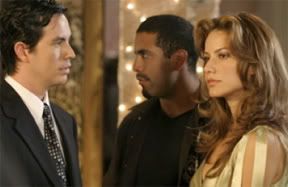 "The Invitation" is the second film I worked on with Alberto Barboza, a director and friend I met at UCLA film school. "Premeditation," which was Alberto's thesis short film, generated momentum with favorable response at festivals, garnering an award at the LA Latino International Film Festival that led to attention from Showtime. Showtime provided air dates for "Premeditation," in addition to funding for a second film, which became "The Invitation."
"The Invitation" is the second film I worked on with Alberto Barboza, a director and friend I met at UCLA film school. "Premeditation," which was Alberto's thesis short film, generated momentum with favorable response at festivals, garnering an award at the LA Latino International Film Festival that led to attention from Showtime. Showtime provided air dates for "Premeditation," in addition to funding for a second film, which became "The Invitation."
The story centers on two young painters, each of whom are being promoted at a gallery opening by a husband-wife team of art sellers. There is competition among the artists and among the gallery owners, Gloria and Marco, to outsell the work of their chosen protegés, and determine who will be established as the new sensation in the fickle art world. The film reveals that in the world of art, as elsewhere, success is often determined by political machinations and one's willingness to sublimate their personal values to overcome the competition.
Although some key crew positions carried over from "Premeditation," such as DP Chris Bernal, I did not edit the film. This time out, the production team had the honor of working with the great Caroline Ross, who has contributed her editing talents to episodes of "The West Wing" and one of the great entries in the political satire/sci-fi genre, "Starship Troopers." I had the pleasure of assisting Miss Ross, and then porting the project over from AVID to my Final Cut bay at the Cimarron Group to do the online. I monkeyed around with the footage during the slow days at Cimarron and came up with this trailer.
The film aired on October 5, 2005 on Showtime and has since played in several festivals.
Tuesday, March 28, 2006
Guess Who's Coming to Breakfast?

This is an old educational filmstrip that was shown to a friend of mine when he was growing up in Albuquerque, New Mexico. He remembered the film and tracked it down through his old teacher. Finding the content interesting, and being surprised that it had been shown in a public school, we decided to preserve it for the ages. This meant cutting up the filmstrip and scanning dozens of images, attempting to adjust for the faded colors and scratches throughout. The audio is still in pretty degraded shape, having come from cassette.
The narration examines the products we use everyday, and the global impact of the corporations that create them. It focuses particularly on the Gulf and Western corporation and their role in sugar harvesting in the Dominican Republic. I do not know when this filmstrip was produced (judging by the clothing and hairstyles, I would guess the late 70's or early 80's), so the information presented is obviously no longer up-to-date.
The topic of the negative effects of globalization is now something of a hot button issue, with WTO conferences provoking violent demonstrations around the world. I don't know if there was as much awareness or sensitivity to these issues in the early 1980's, which makes this filmstrip a curiosity to me.
The recent Hubert Sauper documentary "Darwin's Nightmare" takes a look at the current negative effects of globalization being felt in Tanzania, and I would encourage anyone who finds this filmstrip interesting to seek out that film as well.
One caveat: the filmstrip is broken into two parts and total running time is about 20 minutes.
Friday, February 10, 2006
Mr. Solarsin Has Left the Building
Cheers to Mr. Solarsin Ngoenwichit who recently departed the US for his hometown of Bangkok, Thailand. A painter, restaurateur, and filmmaker (to list only a few of his known occupations), Solarsin returned to Bangkok to further his film producing and directing career. Somehow the Singha won't taste the same without this crazy guy around.
Photo by Pia Tanyakorndilok.
Tuesday, January 31, 2006
Sundance Film Festival 2006
 January in Park City, Utah. One of the biggest and most prestigious film festivals in the US occurs in one of the country's smallest and coldest towns. I would love to have each film that I work on culminate in this kind of an event - where the crew, who has grown into a family of friends, can gather and share their film with enthusiastic audiences in a beautiful chilly-air setting, conducive to scotch-drinking and the kind of laughter that gets warm blood pumping back into your frozen cheeks.
January in Park City, Utah. One of the biggest and most prestigious film festivals in the US occurs in one of the country's smallest and coldest towns. I would love to have each film that I work on culminate in this kind of an event - where the crew, who has grown into a family of friends, can gather and share their film with enthusiastic audiences in a beautiful chilly-air setting, conducive to scotch-drinking and the kind of laughter that gets warm blood pumping back into your frozen cheeks.
The occasion for my attendance this year was the programming of a feature I worked on in early 2005 as an assistant editor. Journey From the Fall is an independently-financed narrative film based on the real-life experiences of Vietnam war "boat people" refugees and those who were imprisoned in North Vietnamese "re-education camps." Working on it was a great learning experience, not only in filmmaking (my first feature in post-prod), but also in a specific socio-historic subject. I made many friends and enjoyed a spirit where people really cared about the work, plus it afforded me the chance to work abroad for a week in Bangkok, Thailand. So I could not have been happier to see the film making its way into the world via Sundance. I will undoubtedly post more about the film in the future, but in the meantime, I encourage anyone to visit the official site and see the film if you have the chance.
So, on to my impressions of Sundance.
"Steer clear of the hype," was the advice one colleague recommended to me when I informed him I would be going. It's true that this event swarms with business and industry types, seeking the hot buy, that handful of films that audiences are buzzing about. Numerous celebrities attend in support of their films, attracting media coverage and showers of corporate swag. Businesses all strive to have their logos placed on or near the bodies of celebrities when the news cameras roll. Evidently, during the first weekend of the festival, there is a "giveaway tent," where attendees can visit the booths of corporate sponsors and walk away with hundreds of dollars in swag. When we arrived on Thursday night, Long Nguyen showed us a nice-looking pair of leather boots he'd scored, in addition to a canvas duffel bag in which to keep the rest of his free goodies.
Sundance has long been regarded as an "indie" film festival, where "mini-major" distributors go to pick up crowd-pleasing movies at a discount. Although there are occasionally legends of the $7,000 film being sold to a major distributor, the unwritten consensus is that films made for less than $1 million have a much harder chance of attracting attention from a buyer, because they were unable to afford the production values that movie-goers have come to expect. Since Sundance results in five or six high-profile theatrical distribution deals a year, each of whose film budgets are usually over $1 million, it has contributed to the paradigm of the "couple million" dollar independent film featuring stars who "work for scale."
As business deals go down day-by-day, gossip spreads among the after-hours parties about how much money this film or that film sold for and who was bidding. Filmmakers and their representatives become protective about information like how much their film actually cost to make. Our film was represented by a publicist and a kind of "sales agent." The sales agent was a young guy named Nguyen who told me that his job was to go to every film that had any buzz associated with it because that's where the buyers would be. He would attend the films and their after-parties and have a drink with buyers and drop our film's title into the conversation and make sure they knew when it was screening. It was wierd, but interesting, knowing that your team had this kind of operative working for it - a kind of viral marketing secret agent.
Indie filmmaking is kind of a catch-22. Like proud parents, filmmakers always want the best for their creations. Whether it be the best cinematographer, the best publicity, or the best theater to show the film in, it is always the best that money can buy. However, the concept of "indie" can be variously interpreted, as different budgets allow more or less material love to be lavished on a production. As the budgets and expenditures go up, whether the money came from a studio bank account or not, people often feel that the film becomes less of a true "independent" film, and more of a large-scale film that mimics the low-budget aesthetic or thematic content of a true independent.
I can understand why this might embitter the zero-budget DV filmmaker. At the same time, I don't think it has gotten any harder in recent years to complete small films and get them noticed than it ever was. John Cassavetes, considered by some to be a kind of godfather of American independent filmmaking, was already a successful Hollywood actor with connections and money before becoming known as a director of his own small, risk-taking films.
Although living in LA has given me a low threshold for glamour, there is a satisfaction to knowing that your product, and by extension your crew, is there on the showroom floor, sharing the spotlight with other known commodities. It's a distance marker, indicating that you may not have arrived yet, but you haven't broken down by the side of the road.
Although I ultimately did steer clear of the hype, it was not necessarily by force of will, but simply because by the last 3 days of the festival, most of the celebrity frenzy seemed to have quieted somewhat. Nevertheless, the streets, bars and shuttles were crowded with festival attendees, and each theater had crowds in front of it with people looking to buy tickets to sold out shows. Talking to fans outside of theaters or riding on the shuttles was a nice way to exchange notes or get film recommendations as well as get some background on what brought people out. Although a lot of attendees are connected to the film industry or to a particular film that has been programmed, many people are simply film enthusiasts on vacation, or people who make films of their own and volunteer at the festival. Every shuttle stop had a volunteer attendant who helped festival goers board the ride bus to get to their theaters. Many of them simply came out because they loved movies. Everyone who was approached for information was amenable to conversation and seemed curious to hear your thoughts or where you were from. I enjoyed being there with a film that brought a sense of internationalism to the table.
I finally got a link up to a photo album from the trip. Many of the best shots were taken by Pia or Santahn. You don't have to be a member to view. Just click "View Photos without Signing In."
iofilm review
Variety review
Film Threat review
Rotten Tomatoes review
Wire Image gallery 1
Wire Image gallery 2



